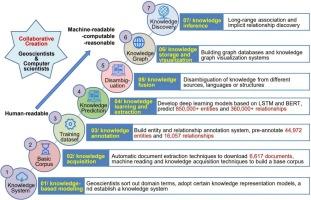Knowledge graph construction and knowledge discovery for porphyry copper deposits
IF 3.6
2区 地球科学
Q1 GEOLOGY
引用次数: 0
Abstract
Porphyry copper deposits (PCDs) are the most important deposit types for essential metals of copper, molybdenum, and gold. However, they are becoming increasingly harder to discover after decades of large-scale worldwide exploration. How to build a more convincing mineral system model, by accurately identifying all indispensable theoretical components from ore deposit formation processes, to guide the PCDs exploration during the modern era of diminishing returns on fixed exploration budgets, is the most urgent work. Knowledge graph (KG), by constructing a graph database to store the concepts and entities and the complex relationships between them, has robust knowledge discovery (KD) ability to obtain new knowledge and conclusions from existing data. With the continuous publication of massive research and literature, studies on PCDs have entered a big data era. Therefore, in this study, we try to use the KG and the following KD to develop a robust workflow for knowledge graph construction and discovery, which facilitates the identification of some indispensable and previously overlooked porphyry mineral system components from published articles, preparing for linking with spatial data and exploration budgets. We provide not only a detailed roadmap for KG construction and KD of PCDs, but also a typical example of the construction and application of KG in geosciences.

斑岩型铜矿知识图谱构建与知识发现
斑岩型铜矿是铜、钼、金等重要金属的重要矿床类型。然而,经过几十年的大规模全球勘探,它们变得越来越难以发现。如何通过准确识别矿床形成过程中所有不可缺少的理论组成部分,建立更具说服力的矿物系统模型,以指导在固定勘探预算收益递减的现代pcd勘探,是当前最紧迫的工作。知识图谱(Knowledge graph, KG)通过构建一个图形数据库来存储概念和实体以及它们之间的复杂关系,具有强大的知识发现能力,可以从已有的数据中获得新的知识和结论。随着大量研究和文献的不断发表,关于PCDs的研究已经进入了一个大数据时代。因此,在本研究中,我们尝试使用KG和随后的KD来开发一个强大的知识图谱构建和发现工作流,这有助于从已发表的文章中识别出一些不可或缺的、以前被忽视的斑岩矿物系统成分,为与空间数据和勘探预算相关联做好准备。我们不仅提供了详细的KG建设路线图和PCDs的KD,而且还提供了地球科学中KG建设和应用的典型实例。
本文章由计算机程序翻译,如有差异,请以英文原文为准。
求助全文
约1分钟内获得全文
求助全文
来源期刊

Ore Geology Reviews
地学-地质学
CiteScore
6.50
自引率
27.30%
发文量
546
审稿时长
22.9 weeks
期刊介绍:
Ore Geology Reviews aims to familiarize all earth scientists with recent advances in a number of interconnected disciplines related to the study of, and search for, ore deposits. The reviews range from brief to longer contributions, but the journal preferentially publishes manuscripts that fill the niche between the commonly shorter journal articles and the comprehensive book coverages, and thus has a special appeal to many authors and readers.
 求助内容:
求助内容: 应助结果提醒方式:
应助结果提醒方式:


